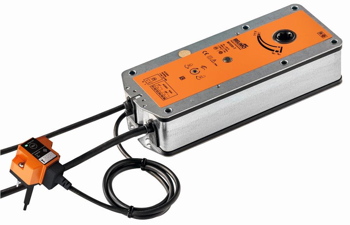Close the door on the spread of smoke and fire

Andy Bartlett explains why motorised fire dampers should be regarded as a key part of fire safety systems in buildings, and what the latest technology has to offer.
Fire safety is high on the priority list for building managers in 2018. We are already seeing the start of a close examination of rules on fire and smoke control in build- ings, so it seems a good time to consider what measures may be available to support better response during a fire, as well as easier maintenance of fire safety systems.
One part of a fire safety system which is often overlooked, and which is largely invisible to occupants, are the fire dampers. Although they’re not easily visible, they are enormously important as they help to prevent the spread of fire and smoke in a building, especially through the HVAC system.
There are two approaches to the technology of fire dampers. The ‘fusible link’ type fire damper operates based on temperature – closing the damper once the temperature exceeds the rating of the fusible link, which is 72oC. In the UK, around 70% of fire dampers used are of this type. The simple technology that activates during a fire is an approach that appeals.
 |
| A fire damper actuator: works with motorised fire dampers as shut-off devices to prevent the spread of fire and smoke |
Motorised benefits
However, we are now seeing a growing interest in motorised fire dampers, which represent about 30% of the market at this time. One of the problems with a fusible link damper is that by the time it operates, the fire must already be well underway. More dangerously for occupants, it means that the building is highly likely to be filling with what is termed ‘cool smoke’, which a bigger killer than fire and almost as damaging to building fabric.
Motorised fire dampers offer a modern approach, because in the case of fire they move into the safety position (i.e. closed). This happens when:
- The fire alarm is triggered; or
- the operating temperature is exceeded in a duct or environment; or
- the damper is triggered by a smoke detector; or
- the supply voltage fails; or
- the air conditioning plant is shut down.
Another benefit of the motorised approach is that on a signal from the building management system, or restoration of power, the dampers can automatically reset to open – ensuring that the building’s ventilation system is returned to normal operation as soon as possible.
A parallel can be drawn between motorised fire dampers and fire doors. Compartmentation is a major method of fire protection in buildings. This approach ensures that the spread of smoke and fire is reduced by cutting off the building into theoretical compartments which are created once the fire alarm is triggered. Fire doors are a crucial part of this. They are generally fitted with mechanical door closers, or with automatic (magnetic / solenoid) devices which release upon a signal from the fire detection system – in order to create compartmentation. Fire doors are not generally held open by mechanical fusible links. The motorised fire damper works in the same way.
Another important point about compartmentation and fire dampers is that full compartmentation may not be achieved until a fire damper has closed (even though the fire doors may have shut automatically). If motorised fire dampers are interfaced to the fire detection system (which is a straightforward process) then they can provide complete compartmentation earlier in a fire than fusible link fire dampers.
 |
| Motorised fire dampers allow for easier longterm maintenance of fire safety systems |
There are several areas of the law, Standards and regulations that point to motorised fire dampers as the modern solution for fire safety. Approved Document B of the Building Regulations (Volume 2 – Buildings other than dwellinghouses) states in Section 10.13:
“Where the use of a building involves a sleeping risk, such as an hotel or residential care home. Fire dampers should be activated by smoke-detector controlled automatic release mechanisms in addition to being actuated by thermally actuated devices.”
The same section also adds: “Fire dampers actuated only by fusible links are not suitable for protecting escape routes. However, an ES-classified fire and smoke damper which is activated by a suitable fire detection system may be used.”
Another very important point for building owners and managers to bear in mind is long-term maintenance of the fire safety system. The law requires regular annual checks and tests on fire dampers. In particular, the Regulatory Reform Order (RRO) states that a ‘responsible person’ must ensure that the building is safe for occupants and visitors. It’s an extremely important requirement, as it puts the onus firmly on the building owner to be responsible for checking and maintaining fire safety systems.
Easier inspection
However, this is easier said than done in the case of fusible link fire dampers. They are hidden in ductwork and may be difficult, if not impossible, to access. A few years ago, it was discovered that a number of PFI hospitals and schools were unable to carry out these checks for that very reason, causing huge concerns about occupant safety.
However, use of motorised fire dampers allows for easier inspection and maintenance, as well as for regular remote testing. They can be linked to the building management system (BMS) to report any issues, providing assurance of operation when they are needed. This could be particularly useful for buildings with vulnerable occupants such as hospitals, care homes and schools.
Andy Bartlett is managing director of Belimo UK.







